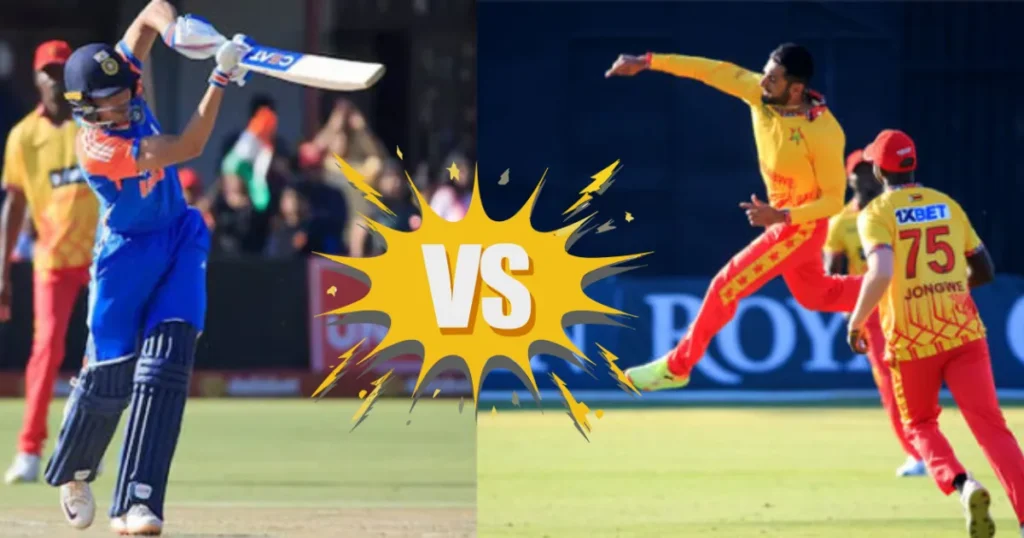The story of Zimbabwe National Cricket Team vs India National Cricket Team Timeline in cricket started in 1983, during the Cricket World Cup in England. Zimbabwe, then a relatively new team on the international stage, faced off against a strong Indian side led by Kapil Dev. This was Zimbabwe’s first-ever World Cup, and they were eager to prove themselves. India, on the other hand, were about to make history by winning the tournament that year.
In that 1983 match, India batted first and posted a solid total. Zimbabwe fought hard but couldn’t chase it down. It was a gentle introduction to their rivalry, with India showing their experience and Zimbabwe learning the ropes. Little did anyone know, this was the start of a fascinating journey.
Zimbabwe earned Test status in 1992, becoming the ninth Test-playing nation. Their first Test match? Against India, of course! Played in Harare, the match ended in a draw, but it was a proud moment for Zimbabwe. They held their own against a team with stars like Sachin Tendulkar and Anil Kumble. This match set the tone for their rivalry—Zimbabwe as the underdog, India as the powerhouse, but always with room for surprises.
Zimbabwe National Cricket Team vs India National Cricket Team Timeline
Here’s a detailed table summarizing key matches between Zimbabwe and India across all formats, based on available data:
|
Year |
Format |
Venue |
Result |
Key Highlights |
|---|---|---|---|---|
| 1983 |
ODI |
England (World Cup) |
India won |
India’s first win in the rivalry during the 1983 World Cup. |
| 1992 |
Test |
Harare |
Draw |
Zimbabwe’s first Test match, against India. |
| 1997 |
ODI |
South Africa (Pepsi Triangular Series) |
Zimbabwe won |
Zimbabwe’s first ODI win against India. |
| 1998 |
Test |
Harare |
Zimbabwe won by 61 runs |
Zimbabwe’s first Test win against India. |
| 1999 |
ODI |
England (World Cup) |
Zimbabwe won by 3 runs |
Zimbabwe’s famous upset in the 1999 World Cup. |
| 2000-01 |
Test |
Delhi |
India won |
Rahul Dravid’s 200* and Javagal Srinath’s 5 wickets. |
| 2000-01 |
Test |
Nagpur |
Draw |
Zimbabwe fought back to level the series 1-1. |
| 2003 |
ODI |
Zimbabwe (World Cup) |
India won |
Match overshadowed by Flower and Olonga’s protest. |
| 2010 |
T20I |
Harare |
India won both matches |
India’s first T20I series against Zimbabwe. |
| 2011 |
ODI |
Ahmedabad (World Cup) |
India won |
India’s comfortable win in the 2011 World Cup. |
| 2015 |
T20I |
Harare |
Series drawn 1-1 |
Zimbabwe’s win in the second T20I was a highlight. |
| 2016 |
T20I |
Harare |
India won 2-1 |
Zimbabwe’s upset in the first match, India’s comeback. |
| 2022 |
ODI |
Harare |
India won 3-0 |
India’s clean sweep with Shubman Gill shining. |
| 2024 |
T20I |
Harare |
India won 4-1 |
Zimbabwe’s shock win in the first T20I, India’s recovery with Abhishek Sharma’s 100. |
Note: This table includes major series and World Cup matches. Total head-to-head stats: In ODIs, India lead 54-10 with 2 ties out of 66 matches. In T20Is, India lead 6-2 out of 8 matches. In Tests, India lead 2-1 out of 4 matches.
The 1990s: Zimbabwe’s Golden Era
The 1990s were a golden time for Zimbabwean cricket. Players like Andy Flower, Heath Streak, and Grant Flower made the team competitive, especially in One Day Internationals (ODIs). During this decade, Zimbabwe pulled off some stunning victories against India, proving they weren’t just here to participate—they were here to win.
One of the biggest moments came in the 1997 Pepsi Triangular Series in South Africa. Zimbabwe beat India in an ODI, their first-ever win against them in the format. It was a huge deal for Zimbabwean fans, showing that their team could take on the giants. The following year, in 1998, Zimbabwe shocked India again, this time in a Test match in Harare. Batting first, Zimbabwe set a challenging total, and their bowlers, led by Heath Streak, bowled India out for just 193 in their second innings. Zimbabwe won by 61 runs, marking their first Test victory against India.
The 1999 Cricket World Cup brought another iconic moment. On May 19, 1999, Zimbabwe faced India in a group-stage match. Batting first, Zimbabwe posted a modest total, but their bowlers, including Henry Olonga, defended it brilliantly. They beat India by three runs in a nail-biting finish, one of the biggest upsets of the tournament. This win helped Zimbabwe finish fifth in the Super Sixes stage, just missing the semifinals.
These victories showed Zimbabwe’s potential. They were a team that could challenge anyone on their day, especially at home. For India, these losses were a reminder not to underestimate their opponents, no matter how small the cricketing nation.
The 2000s: Challenges and Comebacks
The early 2000s were a mixed bag for Zimbabwe. While they continued to produce talented players, political issues in the country started affecting the team. Meanwhile, India were growing stronger, with a golden generation of players like Rahul Dravid, Sourav Ganguly, and Virender Sehwag.
In 2000-01, India hosted Zimbabwe for a two-Test series. The first Test in Delhi was dominated by India, thanks to a double century by Rahul Dravid and a five-wicket haul by Javagal Srinath. India won comfortably, but Zimbabwe fought back in the second Test, ending the series in a 1-1 draw. This showed their resilience, even when things weren’t going their way.
The 2003 Cricket World Cup, co-hosted by Zimbabwe, South Africa, and Kenya, was a tough time for Zimbabwe. Political unrest led to protests, and players like Andy Flower and Henry Olonga wore black armbands to “mourn the death of democracy” in Zimbabwe. This caused a stir, and both players were forced to leave the team soon after. On the field, India beat Zimbabwe comfortably in their group-stage match, but the off-field drama overshadowed the game.
By 2005, Zimbabwe’s cricket was in decline. After a string of poor performances, they voluntarily suspended themselves from Test cricket, with encouragement from the International Cricket Council (ICC). During this period, India continued to dominate their encounters, especially in ODIs. However, Zimbabwe still managed occasional surprises, like reaching the finals of a triangular tournament in 2001 that included India and Sri Lanka.
The 2010s: T20s and Zimbabwe’s Return
The 2010s brought a new format to the rivalry—T20 Internationals (T20Is). The shorter, faster game suited Zimbabwe’s aggressive style, and they showed they could still compete with India. In 2010, the two teams played their first T20I series in Harare. India, led by Suresh Raina, won both matches, but Zimbabwe gave them a scare with their spirited batting and fielding.
Zimbabwe returned to Test cricket in 2011 after a six-year break, hosting Bangladesh in a one-off Test. While they didn’t face India in Tests during this period, their ODI and T20I clashes continued. The 2015 T20I series in Harare was a thriller, with each team winning one match, resulting in a 1-1 draw. Zimbabwe’s win in the second T20I was a highlight, as they chased down India’s total with smart batting from Chamu Chibhabha.
In 2016, India toured Zimbabwe for a three-match T20I series. Led by MS Dhoni, India won 2-1, but Zimbabwe’s victory in the first match was a shocker. They defended a low total of 145, bowling out India for just 102. This win proved that Zimbabwe could still pull off upsets, even against a star-studded Indian side.
The 2020s: A New Chapter
The 2020s have seen the rivalry continue, mostly in T20Is and ODIs. In 2022, India toured Zimbabwe for a three-match ODI series and swept it 3-0. Led by KL Rahul, India’s young squad, including players like Shubman Gill and Ishan Kishan, dominated. Zimbabwe fought hard, but India’s depth was too much for them.
The most recent chapter came in 2024, when India toured Zimbabwe for a five-match T20I series from July 6 to 14. This series was special because it marked a new era for India. After winning the T20 World Cup in June 2024, senior players like Rohit Sharma, Virat Kohli, and Ravindra Jadeja retired from T20Is. A young Indian team, led by Shubman Gill, arrived in Harare with fresh faces like Abhishek Sharma, Riyan Parag, and Tushar Deshpande.
Zimbabwe stunned India in the first T20I, winning by 13 runs. Defending a modest 115, Zimbabwe’s bowlers, led by Sikandar Raza and Tendai Chatara, bowled out India for 102. It was a famous victory, ending India’s 12-match winning streak in T20Is. However, India bounced back strongly, winning the next four matches to take the series 4-1. Abhishek Sharma’s maiden T20I century in the second match and Sanju Samson’s fifty in the fifth were highlights for India, while Zimbabwe’s Clive Madande and Dion Myers showed promise.
Why This Rivalry Matters
The Zimbabwe National Cricket Team vs India National Cricket Team rivalry isn’t just about wins and losses. It’s about two teams with different stories coming together to create exciting cricket. For Zimbabwe, every match against India is a chance to prove they belong among the best. For India, it’s an opportunity to test their young players against a team known for surprises.
Zimbabwe’s passionate fans, cheering at Harare Sports Club, and India’s massive support, watching from every corner of the world, make these matches special. Players like Andy Flower, Sikandar Raza, Sachin Tendulkar, and Shubman Gill have added their own magic to this rivalry, creating memories that fans cherish.
Looking Ahead
As we look to the future, the Zimbabwe National Cricket Team vs India National Cricket Team rivalry is set to grow. Zimbabwe, under new coach Justin Sammons, are rebuilding with young talents like Dion Myers and Clive Madande. India, with their endless supply of stars, will continue to use these tours to groom players for bigger challenges. The next time these teams meet, expect more fireworks—maybe another upset or a new hero emerging.
Final Thoughts
The Zimbabwe National Cricket Team vs India National Cricket Team Timeline is a tale of grit, surprises, and growth. From Zimbabwe’s early upsets to India’s dominance, this rivalry has given us moments to cheer, gasp, and celebrate. Whether it’s a young fan dreaming of playing like Shubman Gill or an older one reminiscing about Andy Flower’s brilliance, this story connects us all through cricket.
So, the next time Zimbabwe and India face off, grab your snacks, pick a side, and enjoy the ride. You never know when the next big upset might happen!






